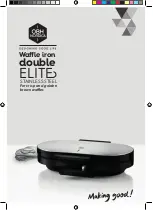
20
If the door panel is stainless steel, stainless steel can discolor when exposed to chlorine
gas and moisture. Clean stainless steel with a mild detergent and warm water solution and
a damp cloth. Never use an abrasive cleaning agent.
Interior cleaning
The ice storage bin should be sanitized occasionally. Clean the water trough before the ice
maker is used first time and reused after stopping for an extended period of time. It is
usually convenient to sanitize the trough after the ice making system has been cleaned,
and the ice storage bin is empty.
1.
Disconnect the power to the unit.
2.
Open the door and take out the removable ice storage bin. With a clean cloth, wipe
down the interior of unit and ice bin with a sanitizing solution made of 1 ounce of
household bleach or chlorine
and 2 gallons of hot (95ºF – 115ºF) water.
3.
Rinse thoroughly with clear water.
4.
Screw off the drainage nut to drain completely.
5.
Put the ice storage bin inside the unit.
6.
Reconnect power to the unit.
The ice scoop should be washed regularly. Wash it just like any other food container.
Condenser cleaning
A dirty or clogged condenser prevents proper airflow, reduces ice making capacity, and
causes higher than recommended operating temperatures that may lead to component
failure. Have the condenser cleaned at least once every six months.
1.
Unplug the ice maker or disconnect power.
2.
Gently pull off the lower front grille.
3.
Locate the condenser filter. This can be lifted out and
cleaned with a brush or flowing water.
4.
Remove dirt and lint from the condenser fins and the unit
compartment with the brush attachment of a vacuum cleaner.
5.
Put back the filter and reassemble the front lower grille.
6.
Plug in the ice maker or reconnect power.
DO NOT use solvent-based cleaning agents or abrasives on the
interior. These cleaners may transmit taste to the ice cubes and
damage or discolor the interior.
Condenser
surface
















































